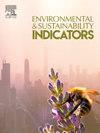Habitat identification and fragmentation risk assessment of key species in the Altai Mountains transboundary region
IF 5.6
Q1 ENVIRONMENTAL SCIENCES
引用次数: 0
Abstract
National boundaries partition transboundary mountains in geographical space, making the process of habitat fragmentation more complex and difficult to coordinate. Biodiversity conservation and maintaining habitat integrity in transboundary mountain regions require global attention and international collaboration. The Altai Mountains are a highly representative transboundary mountain range and one of the global biodiversity hotspots. Finding out the spatial change trends and potential risks of suitable habitats for key species is urgent. This paper applies the MaxEnt model to predict potential habitats and hotspots for flagship species, umbrella species, and representative species with transboundary distribution in the Altai Mountains. A quantitative assessment of the transformation in suitable habitats in the Altai Mountains transboundary region over the past 20 years found that habitat fragmentation and loss showed an increasing trend. This paper argues that enhancing the habitat connectivity of the Altai Mountains can achieve minimum cost conservation and proposes establishing transboundary ecological corridors and networks through international cooperation to promote the coordinated sustainability of the ecological-social system. Our research is significant for global biodiversity conservation and improving human well-being and can provide valuable experience and models for Earth's transboundary protection and sustainable development.
阿尔泰山跨界区关键物种生境识别及破碎化风险评价
国界在地理空间上分割了跨界山脉,使得生境破碎化过程更加复杂,难以协调。跨境山区生物多样性保护和生境完整性维护需要全球关注和国际合作。阿尔泰山脉是极具代表性的跨界山脉,也是全球生物多样性热点地区之一。研究重点物种适宜生境的空间变化趋势和潜在风险是当务之急。本文应用MaxEnt模型对阿尔泰山地区旗舰种、伞形种和跨界分布代表性物种的潜在生境和热点进行了预测。对近20年来阿尔泰山跨界地区适宜生境变化的定量评价发现,生境破碎化和丧失呈增加趋势。本文认为,加强阿尔泰山区生境连通性可以实现最小成本节约,并建议通过国际合作建立跨界生态廊道和网络,促进生态社会系统的协调可持续性。我们的研究对全球生物多样性保护和人类福祉的改善具有重要意义,为地球的跨界保护和可持续发展提供了宝贵的经验和模式。
本文章由计算机程序翻译,如有差异,请以英文原文为准。
求助全文
约1分钟内获得全文
求助全文
来源期刊

Environmental and Sustainability Indicators
Environmental Science-Environmental Science (miscellaneous)
CiteScore
7.80
自引率
2.30%
发文量
49
审稿时长
57 days
 求助内容:
求助内容: 应助结果提醒方式:
应助结果提醒方式:


